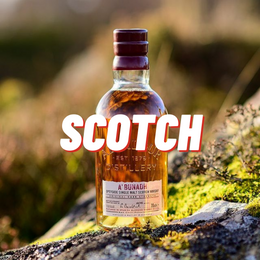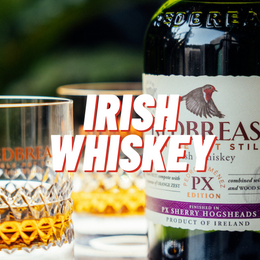
“There’s a special rung in hell reserved for people who waste good Scotch.”
- Michael Fassbender’s character in Inglorious Basterds
There’s this thing called whisky. You might have heard of it.
It graces the cabinets of leaders like Winston Churchill, Queen Elizabeth II and even the Pope. A bottle was buried with legendary Frank Sinatra. It provided company and literary inspiration to the likes of Lady Gaga, Ernest Hemingway and Haruki Murakami. For decades, iconic characters on the screen conspicuously consume it, the likes of James Bond, Ron Swanson, Thomas Shelby and Harvey Specter.
There is just something about whisky that draws people to it.
But what exactly is whisky? Is it the same as beer, brandy or rum?

OK - let’s keep it simple. We can think of whisky as a more potent version of beer that has spent some time in a barrel.
How is it different from rum or brandy, wine or beer?
We begin with the ingredients. The type of plant used. Rums are made from fermenting sugar cane, while brandy is from grapes. Whisky comes from fermented cereal grains like barley, corn, rye and wheat.

Then comes the distillation process. Fermentation of cereal grains create a sugary, malty, beer-like substance called “distiller’s beer”. This “beer” goes through several cycles of distillation to create a very high-proof spirit of around 60%-70% ABV.

Finally, maturation. The spirit is then encased in a wooden cask for several good years of maturation, during which the wood imparts a pleasant vanilla or caramel taste with a coconut-like aroma.

And that’s how we have our iconic golden liquid!
In short, whisky is a booze distilled from a fermented grain mixture, then matured for several years in a wooden cask. Rules vary from country to country, but in general, whisky must be bottled at a minimum of 40% ABV, and aged for about 3 years.
For the full picture of the whisky-making process, check out our article on whisky-making.
Who cares?
Whisky is rather timeless. Almost like how Beethoven’s symphonies are still performed today, or how we find ourselves singing along when The Beatles’ hits come on the speaker.
Whisky hasn’t changed much since it was invented about 300 years ago, and celebrated artists, leaders, performers and thinkers, old and new, indulge in whisky and credit it for adding more colour to life.
There are too many reasons why. One compelling reason is the magical fact that you can create a stunning diversity of distinct and unusual flavour profiles - whether it is sweet, caramel-ly, fruity, smoky, flowery, ocean-y, peppery, smells of aviation fuel or burnt rubber - from 3 simple ingredients of water, barley and wood.
Little tweaks to the cooking process can create a huge change in flavour or mouthfeel. The location (or terroir) of the ingredients also seem matter - some Scotch whiskies made near to the coast exhibit a mild briny note that could remind one of sea spray.
There is also the captivating stories, personality and philosophy of each distillery that makes people appreciate how each one creates a slightly different flavour, as well as the hundred-year effort put into perfecting their craft.
Why should I care? How should I start with whisky?
Most people are already casual drinkers. This means whisky is one of those “finer things in life” that is relatively accessible to get into, and develop a taste for. “Finer things” clearly have to be enjoyable, but they should be just a little bit complex or provocative to be interesting.
Whiskies fit the bill. They are relatively enjoyable despite having some unusual flavour elements. There is usually a good deal of pleasant flavours in whisky (e.g. vanilla, caramel, fruits or florals), but occasionally some complexity or oddities to titillate and subvert expectations (think barbecue meat, shoe polish, seaweed or diesel).

Differences in flavour tend to show quite significantly between whiskies from different regions. A new drinker can very easily discern a smoky Islay-region whisky from a fruity Highland-style whisky, or a sweet American bourbon from a floral Japanese single malt. On top of regional styles, modern whisky-makers enjoy getting creative and experimental. There is the occasional red wine-cask whisky, rum-cask whisky, IPA beer-cask whisky or apple cider-cask whisky. These creations tend to taste quite different from ordinary cask whisky and always make for fresh and interesting experiences.
Whisky gets better each time you drink it. As casual whisky drinkers develop a more precise palate, they gradually notice more complexities, textures and layers of flavour in good bottles.
Want to get started? We recommend beginners to start with lower proof and gentler-tasting whiskies, such as Highland-style Scotch or non-age statement Japanese whiskies.

How do you drink whisky? To comfortably taste it, just take a small sip of it as you would a hot coffee. Let the liquid sit on your tongue and flavours develop for a good 10 seconds or so. If you are comfortable with the alcohol level, take a deeper sip.
As you savour the glass, consider the history that has gone into it, its origins in a medieval monk’s monastery, the Scottish respect for tradition and Japanese dedication to refinement, the terroir and place where ingredients are harvested, the unusual distillation or maturation processes, and above all, the company of friends over a bottle of good Scotch.
There are plenty of different bottles out there. There’s at least one for each of us.




